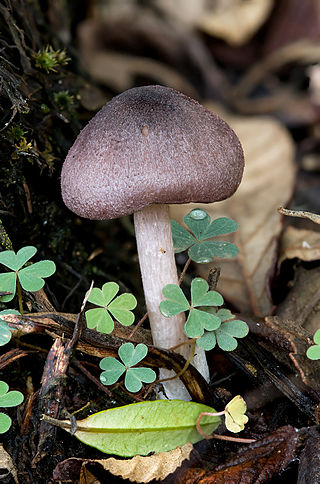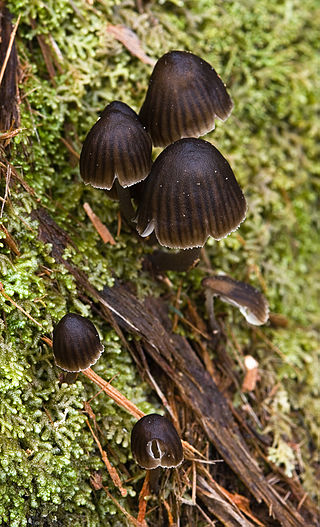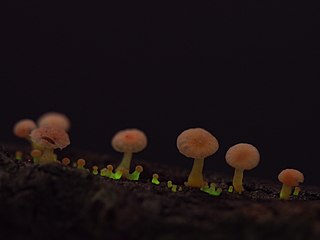
Porpolomopsis lewelliniae, commonly known as the mauve splitting wax-cap, is a gilled fungus of the waxcap family found in wet forests of eastern Australia and New Zealand. The small mauve- or lilac-coloured mushrooms are fairly common and appear in moss or leaf litter on the forest floor in autumn, and are biotrophic. The key distinguishing feature is the splitting of the cap dividing down the middle of the individual gills.

Entoloma hochstetteri, also known as the blue pinkgill, sky-blue mushroom or similar names, is a species of mushroom that is native to New Zealand. The small mushroom is a distinctive all-blue colour, while the gills have a slight reddish tint from the spores. The blue colouring of the fruit body is due to azulene pigments. Whether Entoloma hochstetteri is poisonous or not is unknown.

Macrolepiota clelandii, commonly known as the slender parasol or graceful parasol, is a species of mushroom-forming fungus in the family Agaricaceae. The species is found in Australia and New Zealand, where it fruits singly or in small groups on the ground in eucalypt woodlands, parks, and roadsides. It is a tall mushroom up to roughly 20 cm (8 in), with a broad cap covered with distinctive rings of dark brown scales. The whitish gills on the cap underside are closely spaced and free from attachment to the slender stipe, which has a loose ring on its upper half, and a bulbous base. The edibility of the mushroom is not known with certainty, but closely related parasol mushrooms are edible and some are very sought after.

Mycena haematopus, commonly known as the bleeding fairy helmet, the burgundydrop bonnet, or the bleeding Mycena, is a species of fungus in the family Mycenaceae, of the order Agaricales. It is widespread and common in Europe and North America, and has also been collected in old Japan and Venezuela. It is saprotrophic—meaning that it obtains nutrients by consuming decomposing organic matter—and the fruit bodies appear in small groups or clusters on the decaying logs, trunks, and stumps of deciduous trees, particularly beech. The fungus, first described scientifically in 1799, is classified in the section Lactipedes of the genus Mycena, along with other species that produce a milky or colored latex.

Cortinarius archeri is a species of mushroom in the genus Cortinarius native to Australia. The distinctive mushrooms have bright purple caps that glisten with slime, and appear in autumn in eucalypt forests.

Mycena galericulata is a mushroom species commonly known as the common bonnet, the toque mycena, the common mycena or the rosy-gill fairy helmet. The type species of the genus Mycena was first described scientifically in 1772, but was not considered a Mycena until 1821. It is quite variable in color, size, and shape, which makes it somewhat difficult to reliably identify in the field. The mushrooms have caps with distinct radial grooves, particularly at the margin. The cap's color varies from grayish brown to dark brown and the shape ranges from bell-like to bluntly conical to flattened with an umbo. The stem is hollow, white, tough and thin, without a ring and often roots deeply into the wood on which it grows. The gills are white to grayish or even pinkish when mature and are connected by distinct cross-veins. The caps can reach 4 cm (1.6 in) in diameter, and have a mealy odor and taste. The spore print is white and the gills are pink at maturity, which can lead to possible confusion with species of the genus Pluteus. M. galericulata mushrooms grow mostly in clusters on the well-decayed stumps of deciduous and coniferous trees from spring to autumn. The species can generally be considered inedible. It is common and widespread in the entire temperate zone of the Northern Hemisphere, but it has also been reported from Africa.

Mycena cinerella, commonly known as the mealy bonnet, is an inedible species of mushroom in the family Mycenaceae. It is found in Europe and the United States, where it grows in groups on fallen leaves and needles under pine and Douglas fir. The small grayish mushrooms have caps that are up to 1.5 cm (0.6 in) wide atop stipes that are 5 cm (2.0 in) long and 2.5 mm (0.10 in) thick. Its gills are grayish-white and adnate, with a "tooth" that runs slightly down the stipe. The fungus has both two- and four-spored basidia. As its common name suggests, it smells mealy.

Mycena inclinata, commonly known as the clustered bonnet or the oak-stump bonnet cap, is a species of mushroom in the family Mycenaceae. The doubtfully edible mushroom has a reddish-brown bell-shaped cap up to 4.5 cm (1.8 in) in diameter. The thin stem is up to 9 cm (3.5 in) tall, whitish to yellow-brown at the top but progressively becoming reddish-brown towards the base in maturity, where they are covered by a yellowish mycelium that can be up to a third of the length of the stem. The gills are pale brown to pinkish, and the spore print is white. It is a widespread saprobic fungus, and has been found in Europe, North Africa, Asia, Australasia, and North America, where it grows in small groups or tufts on fallen logs and stumps, especially of oak. British mycologist E.J.H. Corner has described two varieties of the mushroom from Borneo. Lookalike species with which M. inclinata may be confused include M. galericulata and M. maculata.

Mycena sanguinolenta, commonly known as the bleeding bonnet, the smaller bleeding Mycena, or the terrestrial bleeding Mycena, is a species of mushroom in the family Mycenaceae. It is a common and widely distributed species, and has been found in North America, Europe, Australia, and Asia. The fungus produces reddish-brown to reddish-purple fruit bodies with conic to bell-shaped caps up to 1.5 cm (0.6 in) wide held by slender stipes up to 6 cm (2.4 in) high. When fresh, the fruit bodies will "bleed" a dark reddish-purple sap. The similar Mycena haematopus is larger, and grows on decaying wood, usually in clumps. M. sanguinolenta contains alkaloid pigments that are unique to the species, may produce an antifungal compound, and is bioluminescent. The edibility of the mushroom has not been determined.

Entoloma austroprunicolor is a species of agaric fungus in the family Entolomataceae. Described as new to science in 2007, it is found in Tasmania, where it fruits on the ground of wet sclerophyll forests in late spring to early winter. The fruit bodies (mushrooms) have reddish-purple caps measuring up to 5 cm (2.0 in) in diameter supported by whitish stipes measuring 3–7.5 cm (1.2–3.0 in) long by 0.2–0.6 cm (0.1–0.2 in) thick. On the cap underside, the crowded gills are initially white before turning pink as the spores mature.

Mycena nargan, commonly known as the Nargan's bonnet, is a species of fungus in the family Mycenaceae, and the sole member of the section Nargan in the genus Mycena. Reported as a new species in 1995, it is known predominantly from Southern Australia. The saprobic fungus produces mushrooms that grow on well-decayed wood, often on the underside of wood lying in litter. The dark chestnut-coloured caps are covered with white, easily removed scales, and reach diameters of up to 2 cm (0.8 in) wide. The pale, slender stems are up to 5 cm (2.0 in) long and have white scales at the base. On the underside of the cap, the cream-coloured gills are widely spaced and bluntly attached to the stem. The edibility of the mushroom is unknown.
Psilocybe tasmaniana is a species of coprophilous agaric fungus in the family Hymenogastraceae. It was described by Gastón Guzmán and Roy Watling in 1978 as a small tawny orange mushroom that grows on dung, with a slight blueing reaction to damage, known only from Tasmania and southeastern Australia. It was likened to Psilocybe subaeruginosa although characteristics, appearance, and the association with dung were not typical for that species. As a blueing member of the genus Psilocybe it contains the psychoactive compounds psilocin and psilocybin.

Amanita australis is a species of fungus in the family Amanitaceae. It produces small- to medium-sized fruit bodies, with brown caps up to 9 centimetres in diameter covered with pyramidal warts. The gills on the underside of the cap are white, closely crowded together, and free from attachment to the stem. The stem, up to 9 cm long, has a ring and a bulbous base. The mushroom may be confused with another endemic New Zealand species, A. nothofagi, but can be distinguished by differences in microscopic characteristics.

Mycena stylobates, commonly known as the bulbous bonnet, is a species of inedible mushroom in the family Mycenaceae. Found in North America and Europe, it produces small whitish to gray fruit bodies with bell-shaped caps that are up to 15 mm (0.6 in) in diameter. The distinguishing characteristic of the mushroom is the fragile stipe, which is seated on a flat disk marked with distinct grooves, and fringed with a row of bristles. The mushrooms grow in small troops on leaves and other debris of deciduous and coniferous trees. The mushroom's spores are white in deposit, smooth, and ellipsoid-shaped with dimensions of 6–10 by 3.5–4.5 μm. In the development of the fruit body, the preliminary stipe and cap structures appear at the same time within the primordium, and hyphae originating from the stipe form a cover over the developing structures. The mycelia of the mushroom is believed to have bioluminescent properties.

Mycena aurantiomarginata, commonly known as the golden-edge bonnet, is a species of agaric fungus in the family Mycenaceae. First formally described in 1803, it was given its current name in 1872. Widely distributed, it is common in Europe and North America, and has also been collected in North Africa, Central America, and Japan. The fungus is saprobic, and produces fruit bodies (mushrooms) that grow on the floor of coniferous forests. The mushrooms have a bell-shaped to conical cap up to 2 cm in diameter, set atop a slender stipe up to 6 cm long with yellow to orange hairs at the base. The fungus is named after its characteristic bright orange gill edges. A microscopic characteristic is the club-shaped cystidia that are covered with numerous spiky projections, resembling a mace. The edibility of the mushroom has not been determined. M. aurantiomarginata can be distinguished from similar Mycena species by differences in size, color, and substrate. A 2010 publication reported the discovery and characterization of a novel pigment named mycenaaurin A, isolated from the mushroom. The pigment is responsible for its color, and it has antibiotic activity that may function to prevent certain bacteria from growing on the mushroom.

Entoloma haastii is a mushroom in the Entolomataceae family. Described as new to science in 1964, it is known only from New Zealand, where it grows on the ground in leaf litter, usually near Nothofagus species.

Humidicutis mavis is a gilled fungus of the waxcap family. It is found in Australia, Borneo, and New Zealand where the translucent white fungi grows from the ground to a height of 80 mm and a width of 50 mm.

Roridomyces austrororidus, commonly known as the austro dripping bonnet, is a species of agaric fungus in the family Mycenaceae. Described as new to science in 1962 by American mycologist Rolf Singer, it is found in South America, New Zealand, and Australia, where it grows on rotting wood.
Psilocybe germanica is an invalidly described species of psychedelic mushroom in the family Hymenogastraceae. It was described as a new species in 2015 by Jochen Gartz and Georg Wiedemann. DNA sequencing of the balls of P. germanica has found that it is a synonym of P. serbica.

Mycena roseoflava is a species of agaric mushroom in the family Mycenaceae. It was first discovered in 1964 by New Zealand mycologist Greta Stevenson. It is a wood-inhabiting mushroom native to New Zealand.



















